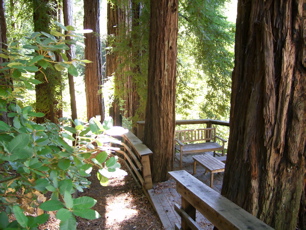I’ve been reading Gary Snyder’s most recent book of essays, Back on Fire (2007). In a couple of the essays, Snyder talks about the two seasons in the Mediterranean-type climate of much of California: there’s the summer-dry season, and the winter-wet season.
It has been odd for me, having recently moved from the south coast of Massachusetts, to hear people in California talk about seasons. We had a cool day a couple of days ago, and I overheard someone in the supermarket say to the cashier, “Fall is finally here.” It doesn’t feel like autumn to me. Autumn means a killing frost, and a changing weather pattern that includes more rain storms, and wide variations between warm and cold. We have not had a killing frost here, nor an increased incidence of rain storms; the earth, where it hasn’t been watered by in-ground irrigation systems, is still hard and parched and cracked dry, and the grasses are still dry and crisp, and the fire danger (as it is every summer in California) is still very high. We are not experiencing autumn here yet; we are still in the summer-dry season.
Somewhere in one of the essays in Back on Fire, Snyder says people living in California should abandon the kind of lawns and landscapes that require heavy water usage in the summer — practices that have been imported from the “Atlantic coast,” says Snyder; although these practices are really indigenous to the English climate, because even on the Atlantic coast lawns need heavy irrigation in the summer in order to stay green. But as a poet, Snyder also gives us new language, so that we can start thinking and acting in new ways. The English language has names for four seasons: winter, spring, summer, autumn or fall; these words come from the land where the English language began. In New England, most years have five seasons: winter, spring, summer, fall, Indian summer; we had to invent a new term for that season between fall and winter when the leaves have all fallen and weather gets warm again and there is still plenty of fresh food for humans and other animals to eat. In this bioregion of California, west of the crest of the Sierras, there are just two seasons, which Snyder calls summer-dry and winter-wet; to try to impose the old English terms for the four English seasons is a kind of self-delusion.
So it does not feel like autumn yet, because there is no autumn here, not really. Winter-wet has not yet begun; the hills are still brown, the trees are dull and faded green; we are still waiting for the first big rain storm of the new season. Yet here near the Pacific coast, we can feel that the weather pattern is changing; the fog is not reliable as it is in the middle of the summer-dry season. (And maybe here we need to add a third season to Snyder’s two, because Snyder lives up in the foothills of the Sierras where there is no summer fog. Maybe we need to talk about a summer-fog season which precedes the real summer-dry season; but I haven’t lived here long enough to be able to say.) We’re still in summer-dry season, but winter-wet season is just around the corner.

